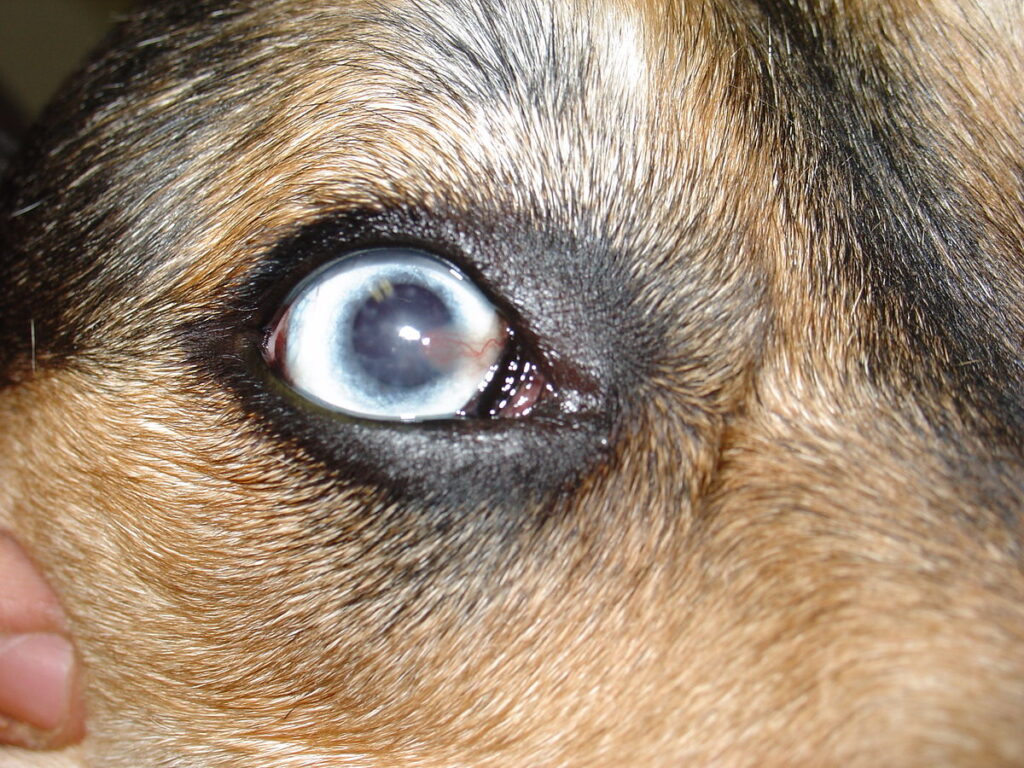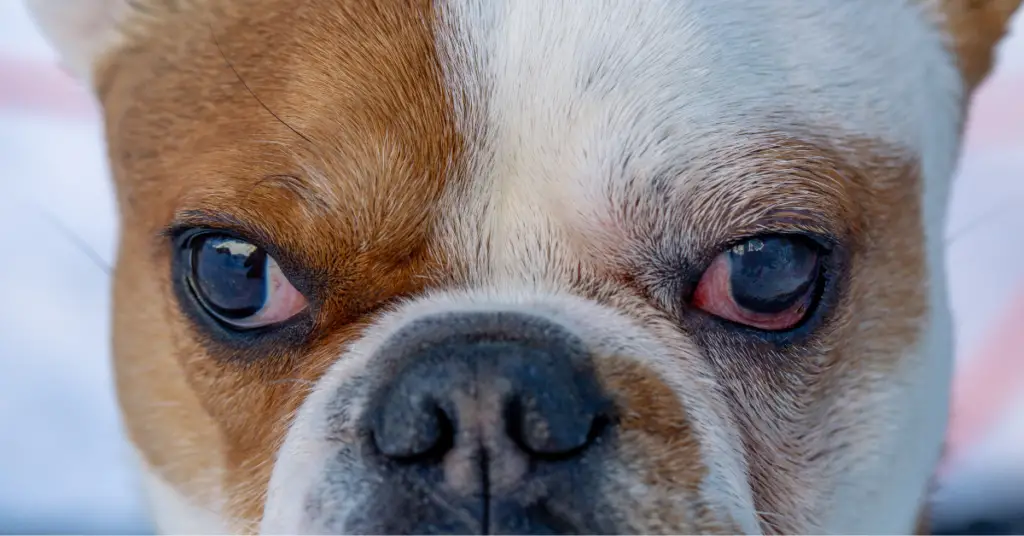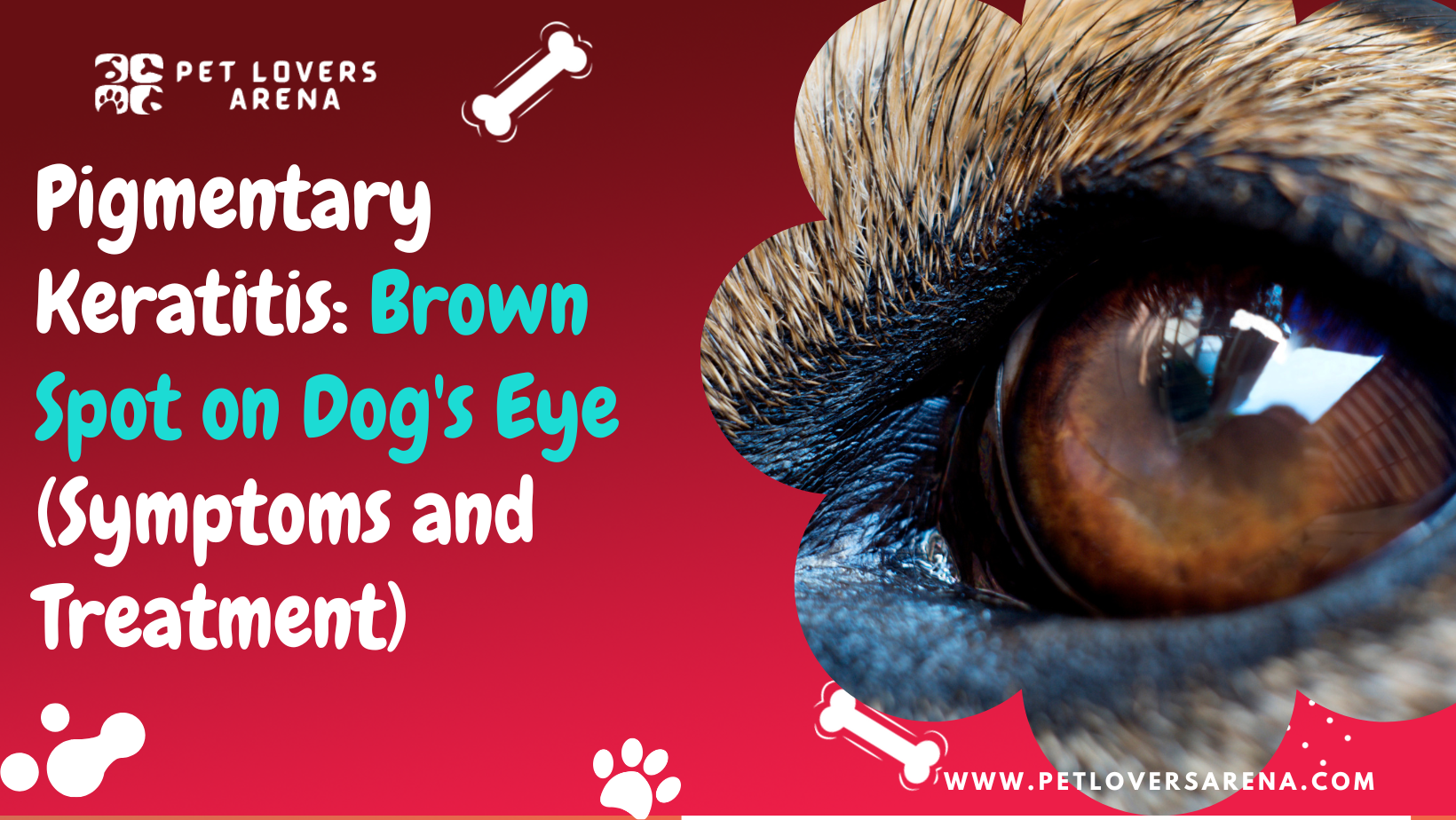The black spots on your dog’s eye could signify pigmentary Keratitis. It is characterized by the development of dark pigmentation on the cornea and the clear outer covering of the eye. It is important to consult with a veterinarian as soon as possible if you notice any black spots on your dog’s eye. This is important as this condition can lead to vision problems or blindness if left untreated. A veterinarian can examine the eye and take a sample of the affected tissue for laboratory analysis to confirm the diagnosis. They may also rule out other potential causes of the symptoms.
Pigmentary Keratitis is a condition that affects the eyes of dogs. It is characterized by the development of dark pigmentation on the cornea and the clear outer covering of the eye. The exact cause of this condition is not fully understood. Still, it is believed to be a result of chronic irritation or inflammation of the cornea. Several factors, including exposure to sunlight, dust, wind, certain medical conditions, or eye infections, can cause this.
Symptoms of Pigmentary Keratitis include dark spots or patches on the cornea, redness, swelling of the eye, and increased sensitivity to light. Treatment typically involves addressing the underlying cause of the condition and managing any symptoms that may be present. Preventing Pigmentary Keratitis in dogs is key to protecting their vision, and regular eye exams are important.
Let’s go into more detail about this condition.
What is Pigmentary Keratitis?

Pigmentary Keratitis, also known as recurrent canine uveitis, is a common eye condition that affects dogs. This condition is characterized by inflammation of the front part of the eye, known as the uvea. This can lead to changes in the color and texture of the cornea, the clear outer layer of the eye.
In addition, the accumulation of stained melanin granules brings on this brownish-blackish discoloration. The most typical breeds of brachycephalic dogs with pigmentary Keratitis are Pugs, Australian Cattle Dog, French Bulldogs, and the Shar Pei.
Bonus Read: Dogs Eyes Rolling Back? Why This Is Happening And How To Stop It?
What Are The Causes of Pigmentary Keratitis in Dogs?

The exact cause of Pigmentary Keratitis is unknown. It is believed to be an autoimmune disorder where the dog’s immune system mistakenly attacks the cells in the eye. The illnesses of the eyelids, such as entropion, ectropion, aberrant lashes, or tumors, are likely reasons for eye disease that can lead to pigmentary Keratitis. Any of these anomalies of the eyelids may result in long-term damage to the eye’s exterior.
Additionally, pigmentary Keratitis may coexist with dry eyes or keratoconjunctivitis sicca. Poor tear formation in these dogs causes ongoing ocular irritation. Dogs with the condition may have irregular blink reflexes. This is because they cannot adequately shield and moisten their eyes, which results in inflammation. Some dogs may have a record of corneal operations in the past or chronic or recurrent corneal ulcers caused by other factors.
Sometimes there is no underlying reason that can be found. In some instances, the pigment remains active even after treating the root issue. These characteristics imply that this illness has a hereditary component. It is probably caused by both hereditary and face conformational variables.
9 Reasons for Brown Spot on Dog’s Eye
Even though a brown mark in your dog’s eye might not be cause for concern, particularly if the spot was present at birth, in rare circumstances, it could be an indication of a serious disease. Any of it might be the cause, from a simple infection to dangerous tumors and ulceration. Following are the reasons why a brown spot is present in your dog’s eye:
Natural pigmentation
Certain dogs are conceived with an eyespot that will stay there for the duration of their life. It is sometimes described as a natural pigment and is thought to be a result of their inherited DNA. Sometimes the problem area seems to grow or worsen over time. Therefore, it is advised to seek medical attention right away before it becomes too late.
Scratched cornea
Additionally, it can be a sign that your dog unintentionally scraped its cornea. It is an extremely painful ailment that, if left untreated, might eventually result in major health problems.
Foreign particles
A brown patch could occasionally not mean anything dangerous at all. Therefore, a contaminant that appears as a brown spot in your dog’s eye may be involved.
Allergies/Infections
Your dog could well have picked up bugs or heartworms from a variety of sources, which can result in infections. Dogs can be harmed by everything from grit to pollen, as you should be conscious. A brown patch on your dog’s eye might thus be a sign of an allergy or infection.
Corneal Ulcer
Corneal ulcers are exceedingly painful. This is a dangerous condition, and if you notice that your dog’s pupils have gone red as well as white or yellow discharges coming from its eyes, it may have a corneal ulcer.
Glaucoma
Your dog might have glaucoma and perhaps other issues. Please be aware that there is a strong probability your dog has glaucoma if one or both of their eyes appears to be protruding or have brown spots in them.
Conjunctival tumors
Your dog could also have surrendered to brown spot-like tumors that are developing in its eyes. Your dog will then appear to have larger eyes.
Horner’s syndrome
A neurological condition called Horner’s syndrome can damage a dog’s facial and eye musculature. There aren’t many other ways that Horner’s syndrome can influence your dog besides sagging or depressed upper eyelids.
Uveitis
Your dog’s eye irritation may also be affecting them. Your dog’s eye may very well be red or inflamed if they have uveitis, a disorder that also goes by that name. Even though the issue is not severe, it is important to keep in mind that if it isn’t addressed quickly, it may eventually result in blindness.
How Do I Know if My Dog Has Pigmentary Keratitis?

Pigment accumulation within the cornea is apparent in dogs with pigmentary Keratitis. This coloration might look anything from little brown spots to vision-impermeable black regions. Owners may frequently see pigmentary Keratitis in normal light settings, but some incidences are only discovered after a closer inspection.
Symptoms of Pigmentary Keratitis include redness and swelling of the eye, cloudy or hazy vision, and sensitivity to light. The cornea can become thickened and pigmented in advanced cases, leading to vision loss.
The pigmentation often starts at the inner part of the eye. It spreads outward to encompass the pupils and the center of the cornea. Light cannot enter the eye if the pigment covers most of the eye; as a result, your dog could have vision problems.
How is Pigmentary Keratitis Diagnosed?

A veterinarian typically diagnoses Pigmentary Keratitis through a thorough eye examination. It may include additional tests such as a Schirmer Tear Test, which measures the number of tears produced. It may also involve a Fluorescein Stain Test, which can detect ulcerations or abrasions on the cornea.
When checking the corneal surface and looking for other concurrent eye conditions, your vet may employ an ophthalmoscope or another source of light. Your veterinarian will start by determining the root cause of pigmentary Keratitis after the problem has been identified.
Next, your dog’s eyes, lids, and vision reflexes will be carefully examined by your vet to search for any anomalies. It can cause the eye’s membrane to irritate. Finally, your vet may occasionally send your dog to an ophthalmologist for a more thorough examination.
Bonus Read: Why Does My Dog Avoid Eye Contact
How Should You Treat a Black or Brown Spot if it Appears in Your Dog’s Eye?
If you notice a black or brown spot in your dog’s eye, it is important to consult your veterinarian as soon as possible. The spot could be a sign of pigmentary Keratitis. This condition affects dogs’ eyes and can lead to vision problems and blindness if left untreated.
Your veterinarian will perform a thorough examination of the eye and may also take a sample of the affected tissue for laboratory analysis to confirm the diagnosis. It can also rule out other potential causes of the symptoms.
Treatment for pigmentary Keratitis typically involves addressing the underlying cause of the condition, as well as managing any symptoms that may be present. This may include topical medications to reduce inflammation and promote healing, such as corticosteroids. Vets may also employ eye drops or ointments to protect the cornea from further damage and lubricate the eye.
In addition, surgery may sometimes be necessary to remove the affected tissue and restore vision. In order to restore the natural eyelid shape and prevent more damage to the cornea, surgical treatments are employed to treat eyelid anomalies.
It is important to follow your veterinarian’s instructions and administer any medications as prescribed. It is also important to bring your dog back for follow-up exams to monitor the treatment progress and make any necessary adjustments. It’s also important to prevent further exposure to the factors that caused the pigmentation to prevent further damage.
Pigmented Keratitis can seldom be completely reversed. It is unusual for the pigment granules on the cornea to disappear completely. However, the pigment may get lighter with time. Nevertheless, reestablishing a proper tear film may allow dark spots to disappear entirely in situations with Keratoconjunctivitis.
Can Pigmentary Keratitis Be Prevented?
Yes, In order to prevent Pigmentary Keratitis, it is important to have regular eye exams for dogs at a higher risk of developing this condition. In addition, if a dog is diagnosed with Pigmentary Keratitis, it is important to follow the veterinarian’s instructions for treatment and to monitor the dog’s eye for any changes or signs of worsening.
FAQ’s
Pigmentary Keratitis is not always painful for dogs. However, in some cases, dogs may experience pain or discomfort due to the inflammation and irritation of the cornea.
Yes, the prognosis for dogs with Melanoma can vary depending on the cancer stage and the tumor’s location. Early detection is key to increasing the chances of recovery, and regular vet check-ups and skin exams are important to detect any changes in the skin.
The length of time that a dog can live with eye melanoma depends on various factors, such as the size and location of the tumor and whether cancer has spread to other parts of the body. The median survival time for dogs with ocular Melanoma that has not spread to other parts of the body is about one year. Still, it can be longer or shorter depending on the specific case, treatment, and overall animal health.
Yes, fungal infections can cause blindness in dogs. Fungal infections can affect the eyes in several ways, causing inflammation, corneal ulcers, and scarring, leading to blindness if left untreated.
Conclusion
In conclusion, Pigmentary Keratitis is a serious eye condition that affects dogs and can lead to a loss of vision. With proper diagnosis and treatment, this condition can be managed and prevented from causing permanent damage to the eye. However, early recognition and management are key, and regular eye exams are recommended for dogs at risk of developing Pigmentary Keratitis.
Meet Fabian Wright, our guide into the animal realm at PetLoversArena.com. Having served as an Animal Care Specialist for the Ruwenzori Team at the Kansas City Zoo, he prioritizes conserving exotic species by replicating their habitats. Fabian aspires to share captivating stories of creatures, big and small, through PetLoversArena.com.

